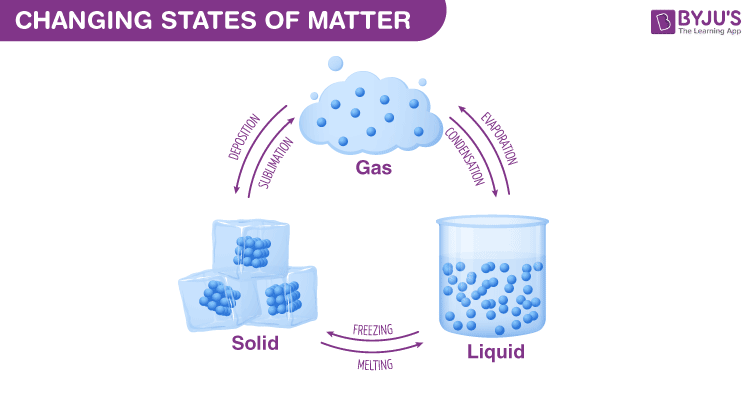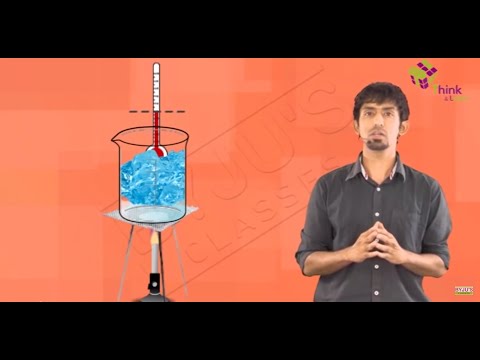Which Change Of State Takes Place When A Gas Loses Energy?
Y'all would have observed changing states of matter when ice cubes cook from solid into liquid water or when water boils into vapor, but have you wondered why substances change class? Changing states of affair occur when matter loses or absorbs energy. When a substance absorbs free energy the atoms and molecules move more quickly and this increased kinetic energy pushes particles far plenty, that they change form. This energy is usually rut or thermal energy. In this article, let the states understand the scientific discipline backside the irresolute states of matter.
You might want to read the following articles for a deeper understanding of the topic.
- Three States of Matter
- Physical and Chemical Changes
What are Changes of State?
A change of state is a physical alter in a matter. They are reversible changes and do not involve any changes in the chemic makeup of the matter. Common changes of the country include melting, freezing, sublimation, degradation, condensation, and vaporization. These changes are shown in the figure given below.

Why do Stage Changes Occur?
When temperature or force per unit area change of a arrangement occurs, phase changes occur. When the temperature or pressure increases, the interaction betwixt the molecules increases. Similarly, when the temperature decreases, it is easier for molecules and atoms to settle into a more rigid construction.
FreezingMeltingVaporizationCondensationSublimationQuestions
Changes Between Liquids and Solids
How would y'all make ice cubes in a tray? Get-go, you lot would fill the tray with water from a tap. So y'all would identify the tray in the freezer compartment of a refrigerator. The freezer is very cold. What happens next?
Freezing
Heat transfer occurs between the warmer tray and the colder air in the freezer. The warm water loses rut to the cold air in the freezer. This heat transfer occurs until no energy is available for the particles to slide past each other. This forces them to remain in fixed positions, locked in identify by the forcefulness of attraction betwixt them. This way liquid h2o is inverse into solid ice. The process of liquid water changing to solid ice is termed as freezing. The temperature at which it occurs is known as the freezing point.
Melting
If you took out the water ice cubes from the freezer and placed them in a warm room, the ice would absorb energy from the warmer air around them. This captivated energy would facilitate them to overcome the force of attraction holding them together, enabling them to slip out of the fixed position that they held as water ice. The procedure in which a solids change to a liquid is called melting. The melting point is the temperature at which a solids change to a liquid.
Watch the video below to clearly understand why water changes to solid when the temperature is reduced and to a gas when the temperature is increased?

Changes Between Liquids and Gases
If yous make full a pot with cold tap water and estrus it on a hot stovetop, the water heats up. Heat free energy travels from the stovetop to the pot, and the water absorbs the energy from the pot. What happens to the h2o next?
Vaporization
If the water is hot enough, it starts to boil. Bubbles of water vapor are formed in the boiling water. This happens as particles of liquid water proceeds enough energy to completely overcome the force of attraction betwixt them and change to the gaseous state. The bubbles ascension through the water and escape from the pot as steam. The process in which a liquid boils and changes to a gas is called vaporization. The temperature at which a liquid boils is its humid point.
Condensation
When you take a hot shower in a closed bathroom, the mirror is likely to fog up. You may wonder why does this happen? Some hot h2o from the shower evaporates and when it comes in contact with cooler surfaces such as the mirror, information technology cools and loses energy. The cooler water particles no longer accept the energy to overcome the forces of attraction betwixt them. They come together and course droplets of liquid water. This process in which a gas changes to liquid is known equally condensation.
Changes Between Solids and Gases
Solids that change to gas passes through the liquid state outset. However, sometimes solids alter directly to gases and skip the liquid state. The reverse can besides occur. Sometimes gases change direct to solids.
Sublimation
The process in which solids straight change to gases is known as sublimation. This occurs when solids absorb enough energy to completely overcome the forces of attraction between them. Dry ice is an instance of solids that undergo sublimation.
| Five Changes of State | ||||
| Melting | Freezing | Evaporation | Condensation | Sublimation |
| The process by which a substance changes from the solid phase to the liquid stage is known as melting. | The process by which a substance changes from the liquid phase to the solid stage is known as freezing. | The process by which a substance changes from the liquid stage to the gaseous stage is known equally evaporation. | The procedure by which a substance changes from the gaseous stage to the liquid phase is known as condensation. | The transition of the solid phase to the gaseous phase without passing the intermediate liquid stage is known as sublimation. |
Conclusion
It volition interest yous to know that every object in beingness undergoes a state change. It is only a question of the amount of rut supplied to the substance. If you supply plenty estrus, everything on this planet tin can be made to change its state. The thing is though not every substance has to follow the solid-liquid-gas path. Some substances can naturally change from their solid-state to their gaseous country without entering the liquid state. This phenomenon is known equally Sublimation. Examples of sublimation are, the element Iodine, Dry ice (solid CO2) and high-quality coal which at high-temperature burns and sublimates into vapour.
Stay tuned to BYJU'S to learn more interesting concepts similar changing states of affair with the help of engaging video lessons.
Oft Asked Questions – FAQ'southward
When solids reach their melting indicate, what exercise they become?
Solids transform into liquid when they reach their melting point.
What is the boiling point?
Boiling point is defined as a temperature at which a pure liquid changes into a gas.
What is the melting bespeak?
The melting point is defined as the temperature at which the solid starts to cook.
What is the process in which solids directly transform into a gas?
Ans: Sublimation is defined as the process in which the solid-land changes to a gaseous state without changing into a liquid state.
What is evaporation?
Ans: When the liquid gets converted to gas at all the temperatures, it is known as evaporation.
The world around you is filled with interesting facts like these. Learn all most them at BYJU'S.
Source: https://byjus.com/physics/changing-states-of-matter/
Posted by: fosdickgagainfoute.blogspot.com


0 Response to "Which Change Of State Takes Place When A Gas Loses Energy?"
Post a Comment